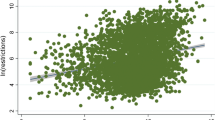Abstract
In this article, we examine how the level of regulation affects the size distribution of businesses. To the extent that regulation functions as a fixed cost, it should lead to larger firm size. However, regulations may also lead to smaller establishments with firms outsourcing regulated activities or staying small to take advantage of state exemptions for small businesses from regulations. We empirically examine the relationship between the size distribution of establishments and the level of regulation using state- and industry-level panel data from 1992 to 2004. Our results suggest that regulation decreases the proportion of zero employee and 1–4 employee establishments. The proportion of establishments in the 5–9 employee range generally increases with the level of regulation. Thus, regulation appears to operate as a fixed cost causing establishments to be larger.
Similar content being viewed by others
Notes
The US Census of Statistics on US Businesses defines an establishment as “A single physical location where business is conducted or where services or industrial operations are performed.” The definition is different from a firm that may consist of several establishments. By using establishment data, we are accounting for every business in the state.
For a similar argument about the (lack) of merits of anti-trust enforcement, see Crandall and Winston (2003).
It should be noted that Klapper et al. (2006) examine only corporations, and they note that in Italy, which has a high regulatory climate, has numerous small firms.
The US Census explains that firms with no employees, or nonemployer firms, are businesses that have no paid employees and are subject to federal income tax. These businesses are what are typically referred to as sole proprietorships. According to the US Census Statistics on US Businesses, these businesses make up the majority of businesses in the US, but only have information reported regarding their number and total receipts. Given that this employment category of businesses is so prevalent, and entrepreneurial, is another reason why examining businesses by the number of employees is relevant.
According to the US Census Classification Manual example activities included in this spending are “[i]nspection of plans, permits, construction, or installations related to buildings, housing, plumbing, electrical systems, gas, air conditioning, boilers, elevators, electric power plant sites, nuclear facilities, weights and measures, etc.; regulation of financial institutions, taxicabs, public service corporations, insurance companies, private utilities (telephone, electric, etc.), and other corporations; licensing, examination, and regulation of professional occupations, including health-related ones like doctors, nurses, barbers, beauticians, etc.; inspection and regulation or working conditions and occupational hazards” (US Census Bureau 2011). Revenue from the regulation of licensing or permits is not included in this data.
In our robustness section, we consider alternative models that employ standard panel fixed effects ordinary least squares (OLS) estimation, drop the sum to zero constraint, and also use log-odds transformations of our dependent variable, and the estimates are robust to these alternative specifications.
Because the specifications without economic and demographic control variables produce similar results, we focus on presenting and discussing the results from the more fully specified models with control variables, but provide the estimates from the models without controls so readers can see the results are robust to excluding these variables.
These tests were conducted using STATA, and the null hypothesis is that the OLS is a consistent estimator. The F-statistics for these tests ranged from 0.01 to 0.77, with P values ranging from 0.9163 to 0.3793, none close to standard levels of significance. In these tests, we used state demographic factors (real per capita personal income, percentage of population aged 65 and older, percentage of population black, percentage of population female and percentage with a college degree) as well as state and time fixed effects to instrument regulatory spending.
There are seven employment categories and from each one we estimate five equations 70 OLS (35 with and 35 without constraints) and 70 log odds ratio equations (35 with and without constraints).
In Appendix 2, the first two results columns show the estimates using our dependent variable as specified in simple percentage, while the final two columns show the estimates using the log-odds transformation. There are two columns for each because we perform the regressions with and without the control variables included (although we always include the full list of fixed effects). All significance levels are computed based on robust, state-clustered, standard errors.
References
Acemoglu, D., & Angrist, J. (1998). Consequences of employment protection? The case of the American with Disabilities Act. National Bureau of Economic Research, Working Paper No. 667.
Ardagna, S., & Lusardi, A. (2008). Explaining international differences in entrepreneurship: The role of individual characteristics and regulatory constraints. National Bureau of Economic Research, Working Paper 14012.
Baumol, W. J. (1990). Entrepreneurship: Productive, unproductive and destructive. Journal of Political Economy, 98(5), 893–921.
Bjørnskov, C., & Foss, N. J. (2010). Do economic freedom and entrepreneurship impact total factor productivity? Department of Strategic Management and Globalization, Working Paper 8/2010.
Bradford, C. S. (2004). Does size matter? An economic analysis of small business exemptions from regulation. The Journal of Small and Emerging Business Law, 8(1), 1–37.
Campbell, N. D., Heriot, K., & Jauregui, A. (2010). State regulatory spending: Boon or brake for new enterprise creation and income? Economic Development Quarterly, 24(3), 243–250.
Campbell, N. D., Rogers, T. M., & Heriot, K. C. (2008). The economic freedom index as a determinant of firm births and firm deaths. Southwest Business and Economics Journal, 16, 37–50.
Coase, R. H. (1937). The nature of the firm. Economica, 4(16), 386–405.
Crandall, R. W., & Winston, C. (2003). Does antitrust policy improve consumer welfare? Assessing the evidence. Journal of Economic Perspectives, 17(4), 3–26.
Davidson, R., & MacKinnon, J. G. (1993). Estimation and inference in econometrics. New York: Oxford University Press.
Davis, S. J., & Haltiwanger, J. (1989). The distribution of employees by establishment size: Patterns of change and comovement in the United States, 1962–85. Mimeo: University of Chicago and University of Maryland.
Davis, S. J., & Henrekson, M. (1999). Explaining national differences in the size and industrial distribution of employment. Small Business Economics, 12(1), 59–83.
Djankov, S., La Porta, R., Lopez-de-Silanes, F., & Shleifer, A. (2002). The regulation of entry. Quarterly Journal of Economics, 117(1), 1–37.
Ekelund, R. B., & Tollison, R. D. W. (2001). The interest-group theory of government. Chapter 17. In F. Shughart II & L. Razzolini (Eds.), The elgar companion to public choice (pp. 357–378). Cheltenham: Edward Elgar.
Gao, F., Wu, J. S., & Zimmerman, J. L. (2008). Unintended consequences of granting small firms exemptions from securities regulation: Evidence from the Sarbanes-Oxley Act. Simon School Working Paper No. FR 07-07.
Hale, A., Borys, D., & Adams, M. (2011). Regulatory overload: A behavioral analysis of regulatory compliance. Mercatus Center at George Mason University Working Paper No. 11-74.
Henrekson, M., & Johansson, D. (1999). Institutional effects on the evolution of the size distribution of firms. Small Business Economics, 12(1), 11–23.
Klapper, L., Laeven, L., & Rajan, R. (2006). Entry regulation as a barrier to entrepreneurship. Journal of Financial Economics, 82, 591–629.
Loveman, G. W., & Sengenberger, W. (1991). The re-emergence of small-scale production: An international comparison. Small Business Economics, 3(1), 1–37.
Lucas, R. (1978). On the size distribution of business firms. Bell Journal of Economics, 9(2), 508–523.
Mulligan, C. B., & Shleifer, A. (2005). The extent of the market and the supply of regulation. Quarterly Journal of Economics, 120, 1445–1484.
Niskanen, W. A. (1968). Nonmarket decision making: The peculiar economics of bureaucracy. American Economic Review, 58(May), 293–305.
Nooteboom, B. (1993). Firm size effects on transaction costs. Small Business Economics, 5(3), 283–295.
Nystrom, K. (2008). The institutions of economic freedom and entrepreneurship: Evidence from panel data. Public Choice, 136(3–4), 269–282.
Pagano, P., & Schivardi, F. (2003). Firm size distribution and growth. Scandinavian Journal of Economics, 105(2), 255–274.
Sobel, R. S. (2008). Testing baumol: Institutional quality and the productivity of entrepreneurship. Journal of Business Venturing, 23, 641–655.
Thomas, L. G. (1990). Regulation and firm size: FDA impacts on innovation. RAND Journal of Economics, 21(4), 497–517.
US Census Bureau. (2011). Federal, state, and local governments: Government finance and employment classification manual: Descriptions of functional categories. Retrieved from http://www.census.gov/govs/www/classfunc66.html.
van Stel, A., Storey, D. J., & Thurik, A. R. (2007). The effects for business regulations on nascent and young business entrepreneurship. Small Business Economics, 28, 171–186.
Weingast, B. R., Shepsle, K. A., & Johnsen, C. (1981). The political economy of benefits and costs: A neoclassical approach to distributive politics. Journal of Political Economy, 89(4), 642–664.
Yandle, B. (1983). Bootleggers and baptists: The education of a regulatory economist. Regulation, 7(3), 12–16.
Zellner, A. (1962). An efficient method of estimating seemingly unrelated regression equations and tests for aggregation bias. Journal of the American Statistical Association, 57, 348–368.
Author information
Authors and Affiliations
Corresponding author
Rights and permissions
About this article
Cite this article
Calcagno, P.T., Sobel, R.S. Regulatory costs on entrepreneurship and establishment employment size. Small Bus Econ 42, 541–559 (2014). https://doi.org/10.1007/s11187-013-9493-9
Accepted:
Published:
Issue Date:
DOI: https://doi.org/10.1007/s11187-013-9493-9




